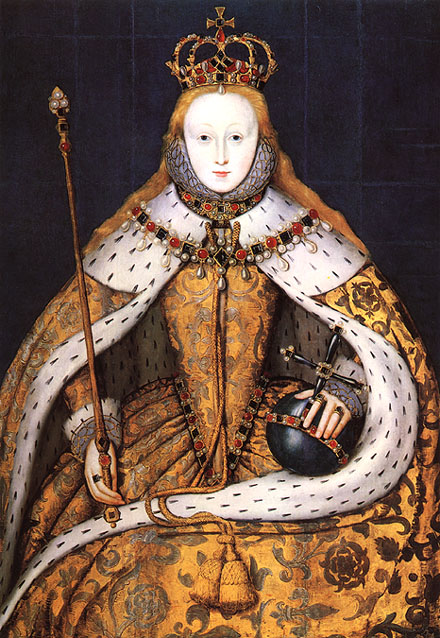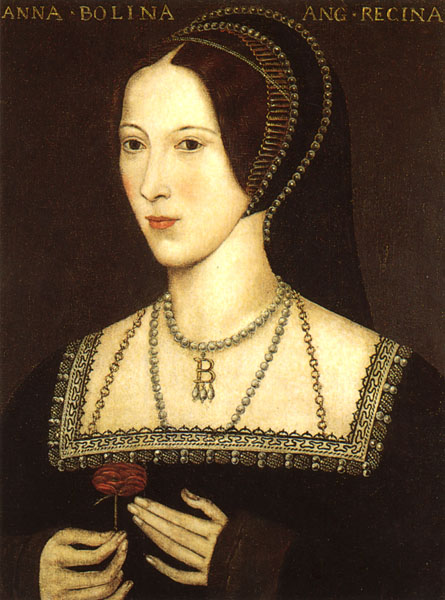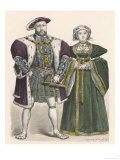Today, or should I says 452 years ago today, Elizabeth I was officially celebrated her coronation. Mary had died and Elizabeth acceeded to the thrown on November 17th 1558, but did not become officially coronated until Sunday, January 15th 1559. Elizabeth was only 25 and her place as Queen was in great jeopardy, either by accusations of being a bastard child of Anne Boleyn and Henry VIII and thus not eligible for the thrown, or threats of assassination which would con

tinue throughout her reign.
On the day before, when she rode in state from the Tower of London to Whitehall Palace, she gave her subjects their first taste of the arts by which she was to win and retain their adoration. It was snowing a little, but the jewels and gilded clothes of those riding in the royal cortege made the day seem almost bright. The Queen herself was carried in an open litter, decked with gold brocade, with a sea of crimson and silver gentlemen-at-arms about her. “slight and somewhat delicate, her long red hair flowing unbound and maidenly (a symbol of virginity) below the circlet of a princess.”
A pageant, brief concert or a recitation occurred at stopping points along the route. These displays represented Elizabeth’s genealogical descent, the virtues of good government and the triumph of Time which brought the realm out of darkness and idolatry into the light of divine truth.
The first pageant laid out Elizabeth's genealogy, stressing her 'Englishness' (as opposed to the 'Spanishness' of Mary, who was half Spanish, and Philip, who was Spanish), and her descent from Henry VII and Elizabeth of York, whose marriage had put an end to years of civil war. The pageant made clear the implication that the granddaughter of those who ended the War of Roses would herself reunify England and bring peace to it. The second pageant showed Elizabeth's government characterized by the four virtues of True Religion, Love of Subjects, Wisdom and Justice trampling their opposite vices, including Superstition and Ignorance. During the third pageant the Lord Mayor presented Elizabeth with a gift of gold, symbolically demonstrating the interdependence of the City and the Crown.
In the fourth pageant, a decaying commonwealth (Mary's) was contrasted with a thriving one (Elizabeth's). It featured the figure of Truth, who was carrying a Bible written in English and entitled the Word of Truth. Truth presented the Bible to the Queen, who kissed it and laid it on her breast to the cheers of the crowd. The task ahead of her was presented in the final pageant, with Elizabeth portrayed as Deborah, the Old Testament prophet, who rescued the House of Israel and then went on to rule for 40 years.
The actual coronation took place the following day, Sunday 15 January 1559, in Westminster Abbey. Elizabeth and her court walked in procession to Westminster Abbey on a purple carpet which disappeared once she passed by. (Crowds cut off parts of the carpet as souvenirs.) Church bells rang upon her arrival at the Abbey.
The ritual itself was a clever compromise between the Catholic practices that existed and the Protestant ones that she intended to introduce. She was crowned in Latin by a Catholic bishop but parts of the service that followed were read twice – in Latin and English. The changes in the service were a portent of the religious settlement to come and symbolic of her 'make-haste-slowly' approach to introducing change. Elizabeth also complained the special anointing oil was “grease and smelled ill”
She emerged from the ceremony to greet her adoring fans wearing a big smile, her crown and carrying the orb and sceptre of her new office.The crowds greeted their Queen enthusiastically, as music played and church bells rang.
Elizabeth changed into a violet velvet dress for her coronation banquet in Westminster Hall. The Queen’s Champion, Sir Edward Dymoke, rode into the Hall, fully armed, to throw down the gauntlet and challenge anyone who disputed Elizabeth’s claim to the throne.The celebrations at court continued for another ten days.
(Elizabeth's Coronation Procession)
 In 1533 on January 25th, Henry VIII and Anne Boleyn secretly wed in London. Anne was the daughter of Thomas Boleyn, later Earl of Wiltshire and Earl of Ormond, and his wife, Lady Elizabeth Howard. As was customary for young women of Noble birth, they would attend a foreign court as a Lady-in-Waiting or Maid of Honour to another Noble woman (typically one of a higher station than the young lady) as a sort of finishing school. Anne completed her education in the Netherlands, and then spent some time as a maid of honour to Queen Mary, and then to 15-year-old Queen Claude of France, with whom she stayed nearly seven years. In the Queen's household, she completed her study of French and developed interests in fashion and religious philosophy. She also acquired knowledge of French culture and etiquette.
In 1533 on January 25th, Henry VIII and Anne Boleyn secretly wed in London. Anne was the daughter of Thomas Boleyn, later Earl of Wiltshire and Earl of Ormond, and his wife, Lady Elizabeth Howard. As was customary for young women of Noble birth, they would attend a foreign court as a Lady-in-Waiting or Maid of Honour to another Noble woman (typically one of a higher station than the young lady) as a sort of finishing school. Anne completed her education in the Netherlands, and then spent some time as a maid of honour to Queen Mary, and then to 15-year-old Queen Claude of France, with whom she stayed nearly seven years. In the Queen's household, she completed her study of French and developed interests in fashion and religious philosophy. She also acquired knowledge of French culture and etiquette. ompeting for her.
ompeting for her.










